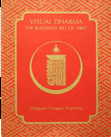Enlightened
Beings
Thangkas of buddhas, gurus and bodhisattvas all fall into this category.
Such figures are visualized in order to identify with the lineage
of spiritual transmission from teacher to disciple, to surrender
and take refuge.
Taking
refuge is a process of freeing oneself from the notion of an external
refuge. It is often said in the Buddhist scriptures that one should
not take refuge in an external god or in external protectors, material
or psychological, such as parents, relatives or wealth. Instead
one should take refuge in the guru-buddha, the embodiment of the
dharma, which is the nature of reality itself. Surrendering means
becoming an empty vessel, becoming emotionally ready to receive
the teaching.
Buddhas
There are three types of buddhas: nirmanakaya buddhas, sambhogakaya
buddhas, dharmakaya buddhas. The main nirmanakaya buddhas are the “buddhas of the three times,”
that is, the buddha of the past age, Dipankara; the buddha of the
present age, Shakyamuni; and the buddha of the future age Maitreya.
The nirmanakaya buddhas are those having human bodies and generally
sharing the human condition. They wear the three robes of a monk,
signifying the complete attainment of discipline, meditation and
wisdom. Their hair is surmounted by an unadorned topknot.
main nirmanakaya buddhas are the “buddhas of the three times,”
that is, the buddha of the past age, Dipankara; the buddha of the
present age, Shakyamuni; and the buddha of the future age Maitreya.
The nirmanakaya buddhas are those having human bodies and generally
sharing the human condition. They wear the three robes of a monk,
signifying the complete attainment of discipline, meditation and
wisdom. Their hair is surmounted by an unadorned topknot.
Sambhogakaya
buddhas are the yidams. There are two Dharmakaya buddhas to be found
in the iconography. Samantabhadra (T.: Kuntu Zangpol Tt.: kun bzang
po) not to be confused with the bodhisattva of the same name, is
the Dharmakaya buddha according to the Old Translation School. He
is depicted naked, symbolizing the formless and simplicity of the
Dharmakaya. He wears the topknot, is dark in color and holds his
hands in the meditation mudra. Vajradhara (T.: Dorje Chang; Tt.:
rdorje chang) is the Dharmakaya buddha according to the New Translation
School. He appears wearing sambhogakaya garments and ornaments,
the same as those of the peaceful yidams. Samantabhadra and Vajradhara
are the primordial buddhas, who represent the totally unconditioned
quality of enlightened mind. According to the New Translation School,
Shakyamuni took the form of Vajradhara to teach the tantras.
Bodhisattva

The bodhisattvas depicted in the iconography are the bodhisattva
mahasattvas, the “great boshisattvas.” They are disciples
of the Buddha Shakyamuni on the sambhogakaya level, ideal figures
who are the complete expression of bodhisattvahood. Each according
to his nature works ceaselessly to bring enlightenment to all sentiment
beings. They also act as spokesmen for sentiment begins to the nirmanakaya
buddhas. Often, it is said, sentiment beings are too confused even
to seek the teachings; therefore the bodhisattvas approach the buddhas,
asking that they turn the wheel of dharma. They also wear the garments
and ornaments of the peaceful yidams, but in the manner of princes
rather than kings. Examples are Avalokitesvara, Manjusri, and Taras.

Gurus
The guru thangkas show the accomplishments, powers and attributes
of the great teachers. For example, Guru Rimpoche appears wearing
several different layers of clothing. He wears the white underrobe
of vajrayana; over that he wears the three robes of a hinayana monk.
Outside these he wears a blue kimono-type gown (T.: per; Tt.: ber),
a vermilion cloak and lotus hat. The gown, cloak and hat are the
costume of a king representing the universal monarch of Mahayana.
These garments signify that he has accomplished all three yanas
and can manifest to his students on whichever of these levels is
appropriate.
Other gurus are
depicted wearing the robes appropriate to their lifestyle of yogi,
monk or pandit. They hold in their hands the appropriate attributes:
a gold wheel for power, sword and book for pandit, begging bowl
for monk, skullcup for yogi, etc. The richness of the lineage and
the teaching is symbolized by highly ornamented robes and richness
of detail.
...........................................................................................................................................................................................................
Essay © 1975 Chogyam Trungpa Rinpoche
copyright © 2003 Shelly and Donald Rubin Foundation
|

